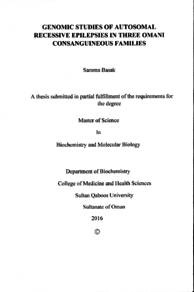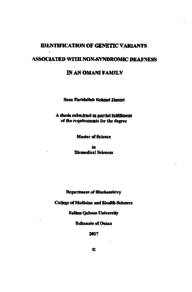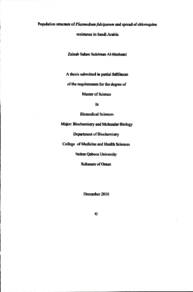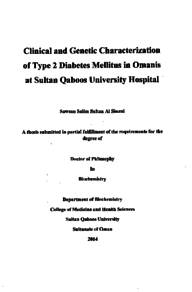Document
Genomic studies of autosomal recessive epilepsies in three Omani consanguineous families
Publisher
Sultan Qaboos University
Gregorian
2016
Language
English
Subject
English abstract
Introduction: Epilepsy is a common, heterogeneous neurological condition whose genetics is only started to be unravelled. Identification of the genes related to epilepsy will increase biological interpretation of the mutated gene therefore gives a better understanding of the origin of the patient's phenotype and gives option for the treatment. Exome sequencing along with homozygosity mapping is a powerful tool which helps to uncover the possible variants in the shared homozygous region among the affected individuals. This study is focused to uncover the genetic basis of autosomal recessive epilepsies in a subset of Omani families. Methods: Three consanguineous Omani families with three apparently different autosomal form of recessive epilepsies were enrolled in the study. The families were diagnosed with Epileptic encephalopathy, epilepsy with secondary generalized seizures and progressive myoclonic epilepsy (PME) respectively. Exome sequencing was performed and the obtained variants were filtered using various filtering strategies. The final variants were biologically interpreted to understand the basis of the phenotype. Pathogenicity was tested using computational tools. The strongest candidate gene was selected and sequenced to confirm nature of variation and for segregation analysis. Results: Variation in PSAP gene was identified in family 3 which as labelled as PME. Co-segregation analysis and functional studies such as mRNA splicing analysis and immunofluorescence microscopy are to be done. Variations in XBPI and ALDH3B1 were identified in the other families, which requires further investigations before pathogenicity can be confirmed. Conclusion: Variation in PSAP was found to be the strongest candidate gene whereas confirmation of variation in XBPI and ALDH3B1 requires more clinical details and investigations
Member of
Resource URL
Arabic abstract
الصرع حالة عصبية شائعة واسعة النطاق، وهنالك الكثير ليتم اكتشافه عن وراثتها. إن معرفة الجينات المرتبطة بالصرع سيفسر بيولوجية الجين المسؤول ويعطي فهما أفضل للنمط الظاهري للمرض وخيارات العلاج. إن تقنية Exome sequencing جنبا إلى جنب مع تقنية Homozygosity mnapping تعد أداة فعالة تساعد على الكشف عن البدائل الممكنة للطفرات الجينية في مناطق التماثل الأليلي بين الأشخاص المرضى. إن هذه الدراسة تهدف للكشف عن بعض الأسس الجينية لأمراض الصرع المتنحية وراثيا في مجموعة فرعية من الأسر العمانية الطرق والمواد: في هذه المشروع تمت دراسة ثلاث عوائل عمانية تتميز بزواج الأقارب مصابة على ما يبدو بثلاثة أنماط مختلفة من أمراض الصرع المتنحية وراثيا : الاعتلال الدماغي الصرعي Epileptic encephalopathy ، والصرع مع نوبات ثانوية عامة epilepsy with secondary generalized seizures ، الرمع الصرعي المستفحل (PME). استخدمت تقنية Exome sequencing لمعرفة المتغيرات الجينية والتي تم تصفيتها وترشيح الطفرات ذوات العلاقة بالمرض باستخدام استراتيجيات مختلفة، وقد فسرت هذه المتغيرات بيولوجيا لفهم النمط الظاهري للمرض، كما تم اختبار العلاقة المرضية باستخدام برمجيات خاصة. وبعد ذلك تم اختيار أقوى الجينات المرشحة وتحديد تسلسلها الجيني لتأكيد طبيعة المتغيرات وتتبع وراثتها بين أفراد العائلة.
النتائج والتوصيات: في هذه الدراسة قد تم تحديد المتغير الوراثي في جين PSAP في الأسرة التي شخصت بمرض الرمع الصرعي المستفحل PME، ولذلك يتعين تتبع وراثة هذا المتغير بين أفراد العائلة والقيام ببعض الدراسات الوظيفية مثل تحليل الربط الجيني في جزي mRNA والفحص المجهري المناعي الإشعاعي. كما تم تحديد المتغيرات الوراثية في الأسر الأخرى في كل من جين XBPI و ALDH3B1 ولكنها تتطلب المزيد من النظر قبل أن يتم تأكيد علاقتها المرضية.
النتائج والتوصيات: في هذه الدراسة قد تم تحديد المتغير الوراثي في جين PSAP في الأسرة التي شخصت بمرض الرمع الصرعي المستفحل PME، ولذلك يتعين تتبع وراثة هذا المتغير بين أفراد العائلة والقيام ببعض الدراسات الوظيفية مثل تحليل الربط الجيني في جزي mRNA والفحص المجهري المناعي الإشعاعي. كما تم تحديد المتغيرات الوراثية في الأسر الأخرى في كل من جين XBPI و ALDH3B1 ولكنها تتطلب المزيد من النظر قبل أن يتم تأكيد علاقتها المرضية.
Category
Theses and Dissertations







